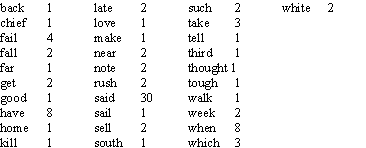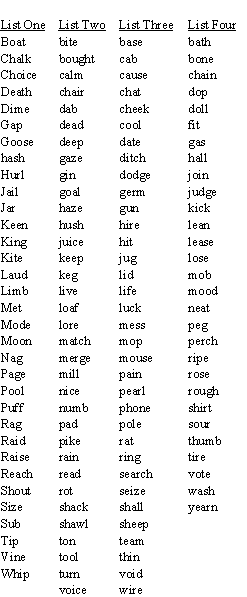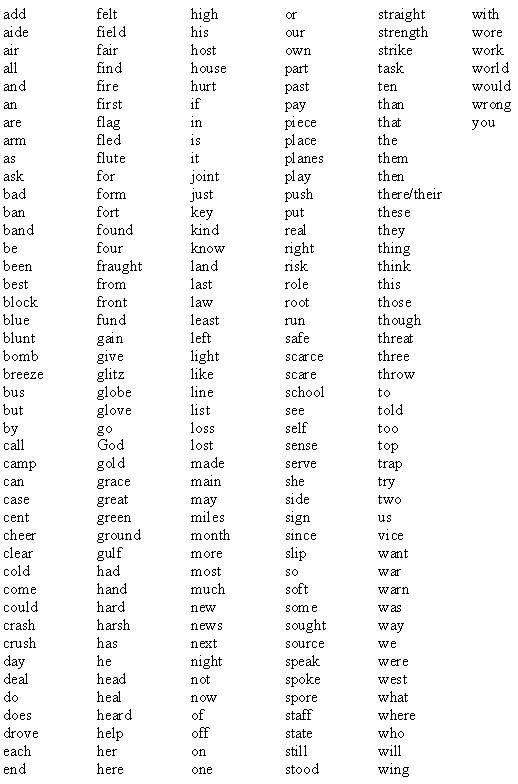This study was conducted to compare the Northwestern University Auditory Test No.6 (NU-6) word list, to common words used today, to assess whether the NU-6 lists represent familiar and common words used in 2002.
History And Development:
Suprathreshold speech-recognition testing, also referred to as speech-discrimination testing, word-recognition testing or speech recognition testing, has been part of the basic audiometric evaluation for more than 50 years. Speech recognition serves many purposes for audiologists and other hearing healthcare professionals and researchers.
The five main uses of word recognition tests include (Gelfand, 1997; Silman & Silverman, 1997):
- To assess the degree of hearing handicap as it relates to communication ability.
- To determine the site of lesion.
- To determine the need for, and to monitor progress in aural rehabilitation.
- To compare hearing aid performance.
- To monitor patient performance over time.
Egan developed twenty "phonetically balanced" lists, each list consisting of 50 words. These lists became known as "PB-50's." The PB-50 lists were derived from Harvard Laboratory speech lists. Phonetic balance was attempted by comparing the speech sounds in each list to the relative occurrence of phonemes in a survey of 100,000 words in newsprint, based on a study conducted by Dewey in 1923.
It was soon discovered that Egan's PB lists only approximated phonetic balance. Nonetheless, it was determined that speech recognition ability could be assessed using the lists. The word lists developed by Egan were soon used in audiology. In later years, however, the vocabulary in the lists and the clarity of recordings came under scrutiny, leading to the development of two other lists. The two lists are well known and are still in clinical use today. The two lists are: the Central Institute for the Deaf (CID) W-22 list and the Northwestern University Auditory Test No. 6.
The CID W-22 test list was the first to be developed after Egan's PB-50 test lists. The CID W-22 list consisted of 200 words, arranged into four lists of 50 words each. The W-22 test includes 120 of Eagan's original PB-50 words. Phonetic balance was achieved to a higher degree by comparing the words used on the W-22s to the analysis of spoken English by French, Carter, and Koenig in 1930 as well as Dewey's earlier word analysis (Gelfand, 1997). The words on the W-22 were reported by Silman and Silverman to be among the 4000 most common English words reported by Thorndike in 1932.
Due to research by Lehiste and Peterson (1959), yet another list was developed to improve the phonetically balanced characteristic of speech recognition tests. Lehiste and Peterson suggested a modification of the term "phonetic balance." They theorized that speech recognition was accomplished more on a phonemic basis rather than phonetically (Gelfand, 1997). In an attempt to overcome this conflict, Lehiste and Peterson developed test lists of consonant-vowel nucleus-consonant (CNC) words from earlier work of Thorndike and Lorge (Silman & Silverman, 1997). In later years, Tillman, Carhart, and Wilber revised Lehiste and Peterson's work to create the NU-4 test, a test that included 100 CNC's (Gelfand, 1997). The NU-4 test consisted of two 50-word lists. Three years after the NU-4 lists were created, Tillman and Carhart modified the lists and increased the number of words to 200 to create the audiological test referred to as the NU-6 test. The NU-6 test is comprised of four lists of 50 words, and in addition to the W-22 test, is one of the most commonly used tests in audiological practice today (Gelfand, 1997).
Premise of evaluation:
Clinical experience suggests several potential problems with the NU-6 test. Frequently, patients appear to hear a word but cannot correctly identify it because it appears to be unfamiliar to them. This is evidenced by certain visual cues. Patients may demonstrate a head tilt or a strange look toward the examiner with eye movement that indicates they found the word strange or unusual. At times, while testing younger adults, a word will appear to be somewhat foreign, or even embarrassing to them. This is evidenced by the patient fidgeting or chuckling nervously after the word is repeated. Thus, it appears they may have never heard the word, or do not hear or use the word very often in everyday speech. These clinical observations suggest the need for evaluation of the familiarity of NU-6 words versus present day conversational usage.
Method:
To provide a representative sample of monosyllabic words commonly used in present day English, words were extracted from three local newspaper articles in Nebraska. The first was a front-page article, selected to represent words used in national reporting, titled, "CIA Told to Assassinate bin Laden." The second was an article about local events, titled, "Marching Band Contest Dedicated to Seward Kids." The third article was chosen from the "World" section, to represent language used when reporting international news. This article was titled, "Taliban: Commandos Failed." These articles were chosen to represent a cross-section of common language English speakers read everyday.
This "article extraction" method was used by Dewey in 1923. Importantly, newspapers have their own demographic target audiences, and regardless of the paper chosen, it can be assumed that the stories published and the language used are essentially chosen for their compatability or desirability for the target demographic. Therefore, the New York Times, the Wall Street Journal, or the National Enquirer might all represent a pre-selection bias when choosing words and stories from their publications.
To determine the occurrence of monosyllabic words in these samples, the documents were reviewed and each one-syllable word and its relative incidence was noted. The three newspaper articles were combined and one large, combined data base was assembled. A spreadsheet was created to organize and quantify the occurrence of the monosyllabic words. After analyzing each document and collecting the occurence of each one-syllable word, the lists were compared to the alphabetized list of NU-6 words presented by Gelfand in Appendix G of Essentials of Audiology (1997).
The first list was created consisting of words that were on the NU-6 lists and were also present in the three articles (see List #1). This list was detailed on a spreadsheet and the prevalence of each word was noted. The second list was created containing words on the NU-6 lists that were not in the three articles (see List #2). A third (final) list was compiled consisting of the monosyllabic words that were found in the three articles, but were not represented on the NU-6 lists (List #3).
Data Analysis:
A total of 134 words from the NU-6 lists were not found to be present in the three newspaper articles (see list #2). List One of the NU-6 lists contained 33 words that were not found in the three articles. Similarly, NU-6 lists Two, Three, and Four had 37, 35 and 29 words respectively, not found in the three articles. Overall, 67% (134/200) of the words on the original NU-6 test lists were not found in the three articles sampled for this study.
Conclusions and Recommendations:
Due to the fact that 67% of the words on the NU-6 test lists were not found in the three articles, it appears there are differences between the words the average English speaking person is exposed to daily, and the words present on the NU-6 test used for audiological speech testing.
It is evident from List 3 that there are many monosyllabic words used in present day English that are not represented in the lists of the NU-6 test. It is acknowledged that sample size and methodology (see above) must be carefully considered in any interpretation of this data.
However, data suggests that revision of the NU-6 lists may indeed be desirable so more of the commonly used words in the English language could be included. It is suggested that a more comprehensive investigation be conducted to determine the "currency" and desirability of the NU-6 lists in audiological practice.
It appears that a word recognition list composed of the most common words in the English language might be more desirable than the current NU-6 lists, and therefore, further study is recommended.
List #1:
NU-6 words found in samples and their occurrence

List #2:
NU-6 words that were NOT found in samples

List # 3:
Words found in samples, but not represented on NU-6 lists

References
Gelfand, Stanley A. (1997). Essentials of Audiology. New York: Thieme Medical
Publishers, Inc.
Silman, Shlomo., & Silverman, Carol A. (1997). Auditory Diagnosis: Principles and
Applications. San Diego, California: Singular publishing Group, Inc.

